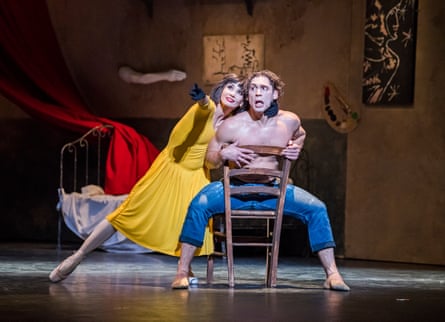English National Ballet, to borrow from TS Eliot, are much possessed by death. They see the skull beneath the skin. Their current season at the Coliseum opened two weeks ago with a double bill of Song of the Earth and La Sylphide, and last week replaced the former with Le Jeune Homme et la Mort. All three, in very different ways, examine notions of mortality.
If Kenneth MacMillan’s spare, beautiful Song of the Earth is essentially uplifting in its message of life’s renewal, Roland Petit’s Jeune Homme was conceived in 1946 as a brutal and calculated exercise in despair. The 20-minute work is often described as existential, but this is to overstate its cerebral character. Which is not to say that it isn’t darkly enjoyable. In the right hands – and Tamara Rojo’s and Ivan Vasiliev’s are absolutely the right hands – the piece is a riot of histrionic overstatement. The ballet tells the story of a young painter who is tormented by his unrequited desire for a cruel muse. He lays his life at her feet, but she taunts him mercilessly and eventually persuades him to hang himself.
With his pantherine leaps and blazing-eyed, silent-movie acting style, Vasiliev is terrific as the young man. As he struts and frets to Bach’s Passacaglia and Fugue in C Minor, costumed in possibly the tightest jeans ever seen on the Coliseum stage, every sinew of his sculpted musculature is taut with angst. Rojo, meanwhile, her hair in a chic little bob, slinks around in a sulphur-yellow frock and black cocktail gloves. At intervals, she evinces her self-absorption through languid developpés à la seconde, presenting her exquisitely arched feet as fetishistic bait. Then, extraordinarily, she seems to change register, all staring eyes and juddering neck. Not so much femme fatale as zombie sex doll.

At 43, Rojo remains the smartest operator on the UK ballet stage. Here, she pays amused homage to Petit’s creation, but subverts the piece’s fearful misogyny and gives it a blade-sharp contemporary edge. Watching Jeune Homme today, at a time when gender relations are being debated with unprecedented intensity, it’s impossible not to see its leads as 21st-century archetypes. He’s no longer the anguished victim of her vampiric soul-sucking, but a man infuriated to the point of self-destruction by a woman who mockingly refuses to recognise the sexual and psychic authority that he has always assumed to be his birthright. The skull that Rojo wears at the end of the ballet was always beneath her character’s skin. It represents the death of the old, masculine order.
August Bournonville’s La Sylphide is a quintessential work of 19th-century gothic romanticism. James (Aitor Arrieta), the ballet’s hero, becomes infatuated with the beautiful but unattainable Sylphide (Alison McWhinney), but in forcibly capturing her – again, no small contemporary resonance here – he kills her. English National Ballet have not fully internalised the Bournonville style, but they dance with fetching sincerity, and Stina Quagebeur’s vengeful sorceress is as thrilling as she is mesmerising.
Star ratings (out of 5)
Le Jeune Homme et la Mort ★★★★★
La Sylphide ★★★

Comments (…)
Sign in or create your Guardian account to join the discussion